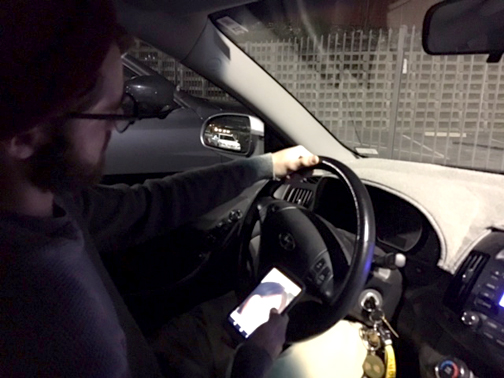
The temptation to check texts and emails while driving can be overwhelming but a recent study released by the AAA Foundation for Traffic Safety reminds drivers of the safety hazards in doing so.
By Mary O’KEEFE
Traffic is a way of life in Southern California and, unfortunately, Crescenta Valley has been experiencing more traffic than residents are used to thanks to the Foothill (210) Freeway construction. Mix with rain and there is the perfect recipe for traffic collisions. But even without the rain and traffic, there is another increasing cause of accidents throughout the United States: distracted driving.
This month the AAA Foundation for Traffic Safety released information concerning the attitudes and behaviors of drivers in the United States.
“As in previous years, the 2016 Traffic Safety Culture Index found that and attitude of ‘Do as I say, not as I do’ persists among motorists, many of who admit to engaging in the same dangerous behavior that they deem as unacceptable,” according to the AAA findings.
What the research found was that drivers aged 19 to 24 were more likely to report reading or typing text messages and more likely to be found texting while driving. In addition they would be less likely to support legislation that would restrict distracted driving.
The study also found that one in nine drivers had been seriously injured in an accident and about one in five had been involved in a serious crash. On the positive side, about 87% stated it was unacceptable to drive without wearing a seatbelt.
Although 81.1% of drivers stated that texting and emailing while driving was a serious threat to safety, about 40% reported they had read a text and/or emailed while driving in the past 30 days.
And thus the “Do as I say, not as I do” attitude prevails.
Distracted driving though is not the only problem for drivers; there is impaired driving and sleepy driving as well. About 60% of drivers in the study stated that driving while using illegal drugs is a serious threat, yet only about 33% of those same people interviewed believed it is less dangerous to drive after using prescription drugs. The majority of the drivers did not approve of drinking and driving and would support laws prohibiting drinking and driving, including installing alcohol interlocks for first time offenders convicted of driving under the influence. Alcohol interlocks are automatic control systems that are designed to prevent driving with excess alcohol by requiring the driver to blow into an in-car breathalyzer before starting the ignition. The alcohol interlock can be set at different levels and limits.
Driving while drowsy is another issue. About 48% of those interviewed agreed that driving while tired is dangerous, yet nearly half admitted to driving when they were so tired they found it difficult to keep their eyes open.
In an unscientific survey conducted by CVW with local teen drivers, it was found that their attitudes aligned with the nationwide findings. A majority interviewed said they “read” texts but normally did not reply. Most did check their messages while driving. Checking music was another distraction that, although they agreed was as dangerous, was still done.
When asked if they felt that older people who text are more dangerous than younger drivers, the majority did not think age mattered.
There was one teen who did have a different opinion.
“I don’t even look at my phone while driving unless I’m stopped or I give it to someone else,” the teen said. “I mean [person texting] can wait, can’t they?”
When asked if they felt that older people who text are more dangerous than younger drivers, the majority did not think age mattered.
There was one teen who did have a different opinion.
“I don’t even look at my phone while driving unless I’m stopped or I give it to someone else,” the teen said. “I mean [person texting] can wait, can’t they?”
